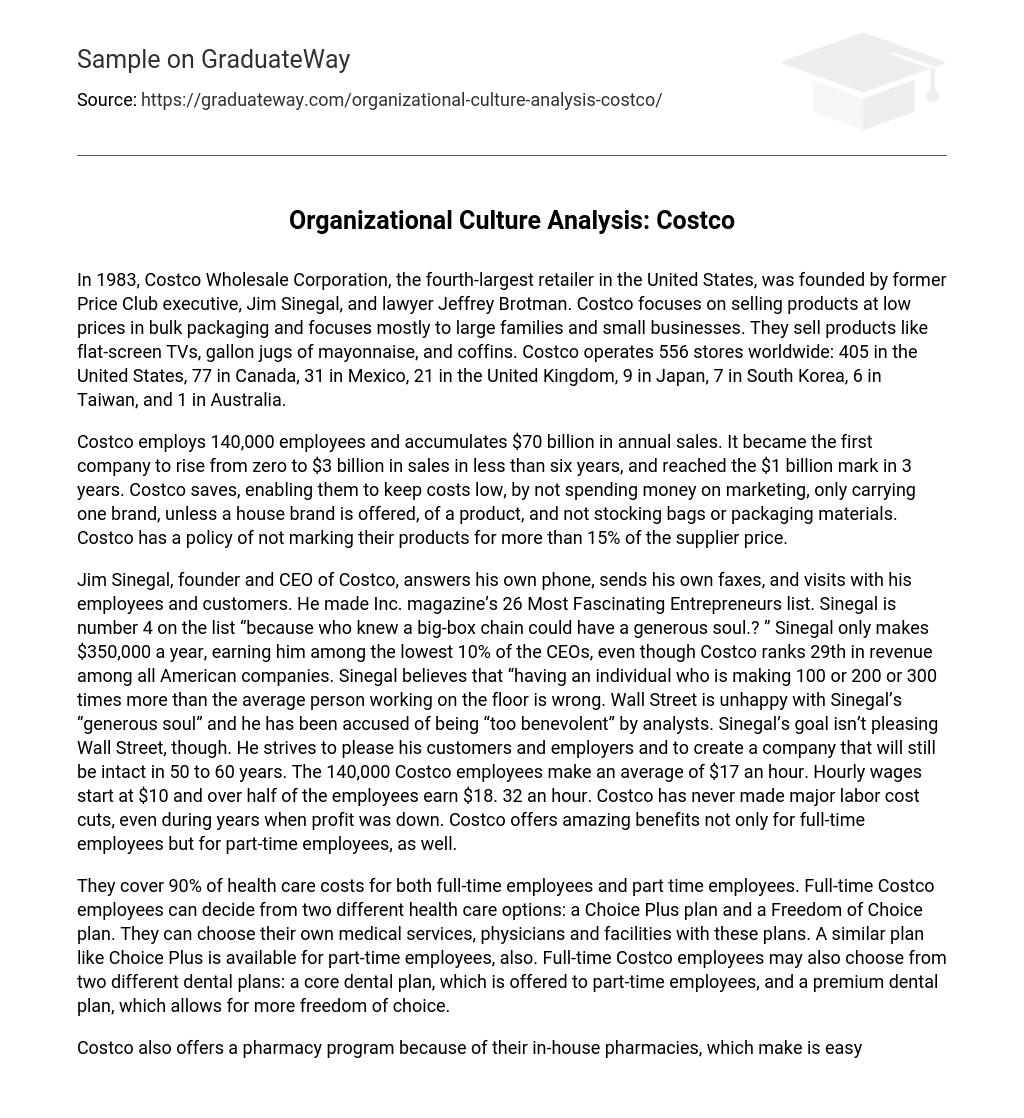Costco Wholesale Corporation, founded in 1983 by Jim Sinegal and Jeffrey Brotman, is the United States’ fourth-largest retailer. Its main focus is providing bulk packaging of low-priced products to cater to large families and small businesses. The extensive range of items includes flat-screen TVs, gallon jugs of mayonnaise, and even coffins. Currently, Costco operates a total of 556 stores worldwide; 405 in the United States, 77 in Canada, 31 in Mexico, 21 in the United Kingdom, 9 in Japan, 7 in South Korea, 6 in Taiwan, and one store located in Australia.
Costco has achieved an impressive feat by reaching $3 billion in sales within six years, making it the first company to accomplish such a milestone. Within just three years, Costco was able to reach the $1 billion mark. In order to keep costs low, Costco employs various strategies such as no marketing expenses, offering only one brand (unless a house brand is available) per product, and not providing bags or packaging materials. Additionally, Costco caps their products’ prices at a maximum of 15% of the supplier price.
Jim Sinegal, the founder and CEO of Costco, is known for his hands-on management approach. He personally handles phone calls, faxes, and interacts with employees and customers. This dedication has earned him the number 4 spot on Inc.magazine’s list of the 26 Most Fascinating Entrepreneurs. What truly sets him apart is his ability to bring compassion to a big-box chain like Costco. Despite being the CEO of a company that ranks 29th in revenue among all American companies, Sinegal chooses to keep his salary modest at $350,000 per year – placing him in the lower 10% of CEO salaries. He believes it’s unethical for someone in his position to earn hundreds of times more than an average worker on the floor.
Sinegal’s benevolent approach has faced criticism from Wall Street and analysts who question its profitability. However, he remains focused on pleasing customers and employees rather than satisfying these critics. His ultimate goal is to build a sustainable company that can thrive for decades to come.
With approximately 140,000 employees at Costco earning an average hourly wage of $17, Sinegal ensures fair compensation within the organization. Starting wages are set at $10 per hour but over half of the employees earn $18.32 per hour.In contrast to numerous firms encountering economic hardships, Costco consistently avoids significant reductions in labor costs as a response to declining profits. The company showcases its dedication to employee well-being by providing exceptional benefits for both full-time and part-time workers.
Costco offers health care coverage to both full-time and part-time employees, with 90% of the expenses being covered. Full-time employees have two choices: the Choice Plus plan and the Freedom of Choice plan, which enable them to choose their own medical services, doctors, and facilities. Part-time employees are eligible for a similar plan called Choice Plus.
Additionally, full-time Costco employees can choose between two dental plans: a core dental plan (also available to part-time employees) and a premium dental plan that provides more options for providers.
Costco’s in-house pharmacies allow employees to conveniently pick up prescriptions at work. Co-payments for generic medications can be as low as $5, and the co-pay for expensive branded drugs is typically capped at 15%. Additionally, Costco warehouses have optical centers that offer ease of access for employees. The vision program covers up to $60 for a refraction eye exam and annual allowances are provided for purchasing corrective lenses.
Costco provides a range of benefits, such as a 401(k) plan, to its employees. The company matches employee contributions at a rate of 50 cents per dollar, with a maximum match of $500 per year for the first $1,000 contributed annually. Additionally, once employees meet certain eligibility criteria, Costco makes annual contributions to their accounts based on a percentage of their eligible earnings. This percentage increases as employees gain more years of service.
Despite having 28% fewer stores, Costco surpassed Sam’s Club in sales in 2003 by 21%, resulting in a 34% increase in their stock value the following year. In contrast, Wal-Mart’s stock value remained unchanged during that time. Over the past five years, Costco has experienced a significant rise of 70% in revenues and their stock has doubled. Jim Sinegal and Jeffrey Brotman have successfully built a company that prioritizes customer satisfaction and employee well-being, distinguishing itself through its emphasis on generosity, kindness, and ethical practices to gain an edge over competitors.





